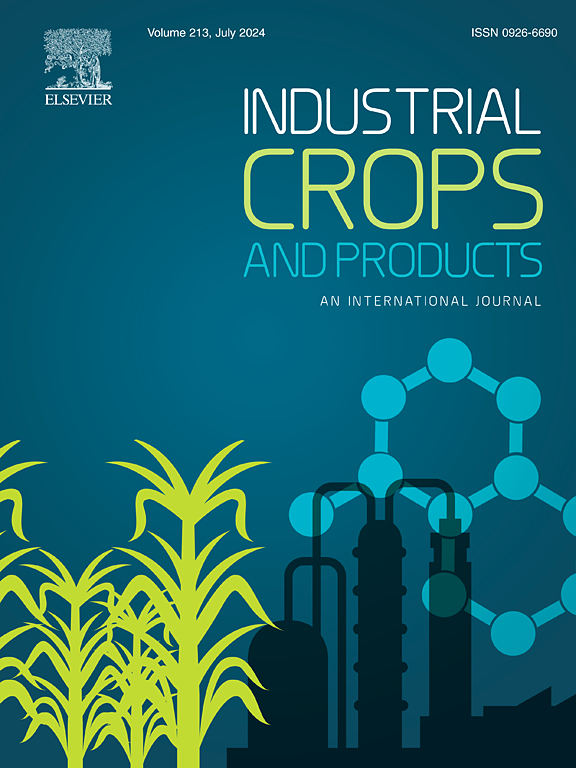酸性深共晶溶剂提取柑橘果皮油和果胶:贮藏效果及RSM优化
IF 5.6
1区 农林科学
Q1 AGRICULTURAL ENGINEERING
引用次数: 0
摘要
标志性水果柑橘(Burm.)产量高,但副产品会造成环境污染。本研究模拟了大黄柑收获后不同阶段的贮藏条件,模拟了不同副产物的养分含量和变化。以6种有机酸为氢键供体(HBD)与氯化胆碱(ChCl)结合,配制了有机酸型深共晶溶剂(OADES);并利用响应面法优化了精油和果胶的得率。研究表明,以草酸为HBD配置的OADES提取率最高。电子鼻结合气相色谱-质谱分析结果表明,精油的挥发性气味主要来自β-月桂烯(38 %)、d -柠檬烯(37 %)和β-蒎烯(4.3 %)。保存30 d以上,精油得率下降27.68 %,主要成分为倍半萜含量下降4.3 %,醇类含量增加7 %。贮藏60 d后,产量下降27.68% %,主要成分为单倍半萜类化合物,产量下降21.8% %,醇类化合物含量增加20.8% %。此外,在整个贮藏期内(0 ~ 60 d),果胶产量呈先上升后下降的趋势,与提取前相比,果胶结构更致密,热稳定性和甲基化程度更高。研究结果不仅为绿色节能提取技术提供了新思路,而且为优化柑橘产业的贮藏繁殖实践提供了有价值的见解。本文章由计算机程序翻译,如有差异,请以英文原文为准。
Extraction of Citrus maxima (Burm.) peel oil and pectin via acidic deep eutectic solvents: Storage effects and RSM optimization
Landmark fruit Citrus maxima (Burm.) is highly productive, but by-products can cause environmental pollution. This study simulates the storage conditions of Citrus maxima at various stages after harvest and models the nutrient content and changes in different by-products. An organic acid deep eutectic solvent (OADES) was configured using six organic acids as hydrogen bond donor (HBD) in combination with choline chloride (ChCl); and the yields of essential oils and pectin were optimized using response surface methodology. The study showed that the OADES configured with oxalic acid as the HBD had the highest extraction rate. The results of electronic nose (E-nose) combined with GC-MS showed that the volatile odors of the essential oils were mainly from β-Myrcene (38 %), D-Limonene (37 %), and β-Pinene (4.3 %). When the raw materials were stored for more than 30 days, the yields of essential oils were decreased by 27.68 %, and the composition was mainly a decrease of 4.3 % in the proportion of sesquiterpenes and an increase of 7 % in alcohols. After 60 days of storage, the yield decreased by 27.68 %, the composition was mainly mono sesquiterpenoids decreased by 21.8 % and alcohols increased by 20.8 %. In addition, throughout the storage period (0–60 d), the pectin yield increased and then decreased, with a denser structure and more thermally stable and methylated pectin compared to the pre-extraction grapefruit peel. The research results not only provide new methods for green and energy-saving extraction technologies, but also offer valuable insights for optimizing the storage and reproduction practices in the citrus industry.
求助全文
通过发布文献求助,成功后即可免费获取论文全文。
去求助
来源期刊

Industrial Crops and Products
农林科学-农业工程
CiteScore
9.50
自引率
8.50%
发文量
1518
审稿时长
43 days
期刊介绍:
Industrial Crops and Products is an International Journal publishing academic and industrial research on industrial (defined as non-food/non-feed) crops and products. Papers concern both crop-oriented and bio-based materials from crops-oriented research, and should be of interest to an international audience, hypothesis driven, and where comparisons are made statistics performed.
 求助内容:
求助内容: 应助结果提醒方式:
应助结果提醒方式:


